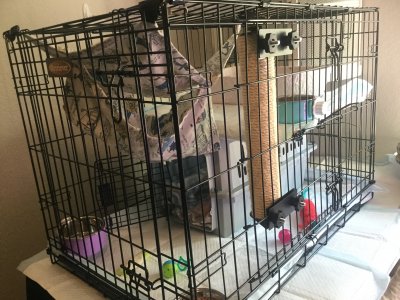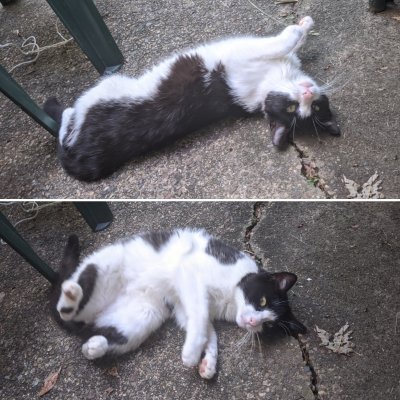Early last year, we started to notice an influx of a few seemingly feral (very avoidant and clean) cats in our suburban neighborhood. We never saw any kittens, but a few months later we saw three new cats, all juveniles (at least 4 months old by their size) who looked exactly like 2 of the known ferals. Now the original cats are gone and we're left with the three littermates, who are likely around 18-20mo old.
I am not usually in this house (my parent's house) or I would have acted on this sooner...
(as a side note, I need to look into TNR for the other cats in this neighborhood, as I've seen no other tipped ears).
The littermates are used to us as we're often outside gardening. They often watch us from bushes, but run away if we get too close. Two of them are still avoidant, but one of them is far less avoidant. This one has a tipped left ear while the others do not, so we're assuming it's been TNRd and may be a reason it is more open to the idea of a human carer. (I'm trying to find out who in my area might have done the TNR).
The tipped cat is small (~10 lbs) and assumed female. All cats are healthy-looking and clean. Starting in March we started to see the tipped cat much more often than before. One day I took out a tiny bit of deli turkey to see if she'd take it, and she did, coming within a few feet of me but, as expected, running away with it to eat alone.
Fast forward to this week. We're feeding her canned food in a bowl we used for my (passed) cat. Occasional crunchy treats to get those teeth clean. She loves the treats, but also likes the canned food. We'll often catch her sitting in wait by the back door. Some days she's hungrier than others. Some days she trots toward me as soon as she sees me. Some days it's a slow approach. She lightly hisses almost every time I approach with the food bowl, but her ears are never back always forward. (Same when my mother does it). But twice now, she's mewed at me, very long and high-pitched sound, when I'm about to set down food. Sometimes she won't eat unless I step back. Sometimes she'll dive right in. Sometimes I have to actually go inside for her to feel safe. She always maintains a 2-3 feet distance, but she doesn't flee from me anymore. In fact, a few times now she's actually followed me (from the mailbox to the front door, for instance).
While these cats grew up around our house this interaction is all very new, so I want to know from those who are experienced if there's any hope for socialization. She's clearly different than her littermates in her trust of me--might be that she's spayed, might just be her personality. But after only two months of feeding we are certainly not at a touch tolerance point. As the weather warms I intend to just relax outside and just hang out, keep treats with me, in the hopes that she'll get even more tolerant of me. But right now isn't the best time to risk infection from a bite, so I'm a bit hesitant on that front.
In any case, I wondered if this cat's current behavior is an indication of potential sociability, or if I should just be content to watch over her from inside, so to speak. I'm absolutely fine letting her be wild and free, so long as she continues to appear content with that.
I am not usually in this house (my parent's house) or I would have acted on this sooner...
(as a side note, I need to look into TNR for the other cats in this neighborhood, as I've seen no other tipped ears).
The littermates are used to us as we're often outside gardening. They often watch us from bushes, but run away if we get too close. Two of them are still avoidant, but one of them is far less avoidant. This one has a tipped left ear while the others do not, so we're assuming it's been TNRd and may be a reason it is more open to the idea of a human carer. (I'm trying to find out who in my area might have done the TNR).
The tipped cat is small (~10 lbs) and assumed female. All cats are healthy-looking and clean. Starting in March we started to see the tipped cat much more often than before. One day I took out a tiny bit of deli turkey to see if she'd take it, and she did, coming within a few feet of me but, as expected, running away with it to eat alone.
Fast forward to this week. We're feeding her canned food in a bowl we used for my (passed) cat. Occasional crunchy treats to get those teeth clean. She loves the treats, but also likes the canned food. We'll often catch her sitting in wait by the back door. Some days she's hungrier than others. Some days she trots toward me as soon as she sees me. Some days it's a slow approach. She lightly hisses almost every time I approach with the food bowl, but her ears are never back always forward. (Same when my mother does it). But twice now, she's mewed at me, very long and high-pitched sound, when I'm about to set down food. Sometimes she won't eat unless I step back. Sometimes she'll dive right in. Sometimes I have to actually go inside for her to feel safe. She always maintains a 2-3 feet distance, but she doesn't flee from me anymore. In fact, a few times now she's actually followed me (from the mailbox to the front door, for instance).
While these cats grew up around our house this interaction is all very new, so I want to know from those who are experienced if there's any hope for socialization. She's clearly different than her littermates in her trust of me--might be that she's spayed, might just be her personality. But after only two months of feeding we are certainly not at a touch tolerance point. As the weather warms I intend to just relax outside and just hang out, keep treats with me, in the hopes that she'll get even more tolerant of me. But right now isn't the best time to risk infection from a bite, so I'm a bit hesitant on that front.
In any case, I wondered if this cat's current behavior is an indication of potential sociability, or if I should just be content to watch over her from inside, so to speak. I'm absolutely fine letting her be wild and free, so long as she continues to appear content with that.






